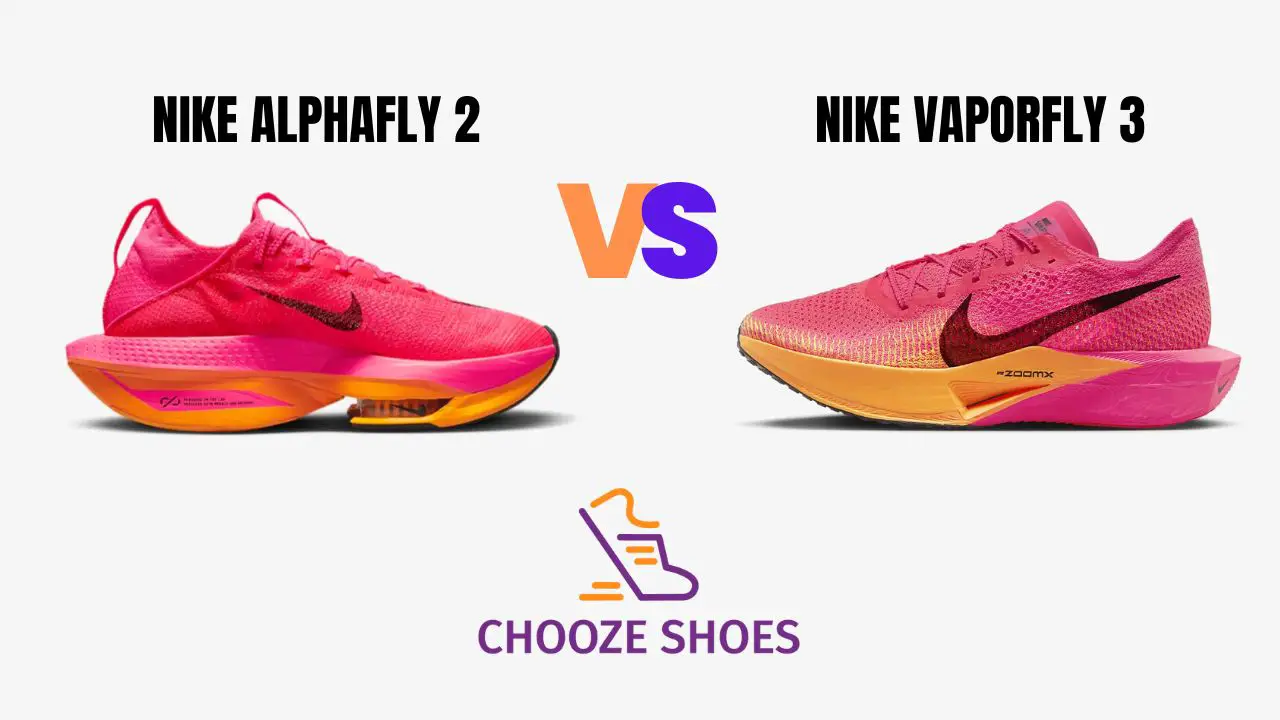Blog
Alphafly 2 vs Vaporfly 3: Which Nike Super Shoe Is Right for You?
Choosing the right super shoe can be a game-changer for your racing performance. Today, we’ll dive into the Alphafly 2 and Vaporfly 3, highlighting their key differences to help you determine which is the best fit for your needs.
Contents
Key Differences Between the Alphafly 2 and Vaporfly 3
Both the Alphafly 2 and Vaporfly 3 are top-of-the-line racing shoes from Nike, offering incredible performance and technology. But, they have some subtle differences that could make one a better choice for you than the other.
Heel
The Alphafly 2 boasts a useful heel loop, making it easy to slip on and off. This feature is particularly helpful for runners who appreciate easy access and extra comfort around the Achilles. The Vaporfly 3 lacks this loop, which might make entry a little trickier. While both shoes provide good cushioning, the Alphafly 2 offers more support across the entire base of the foot and around the Achilles.
Uppers
Both the Alphafly 2 and Vaporfly 3 are designed with breathability in mind, using materials like AtomKnit 2.0 and Flyknit yarns, respectively. While both offer great breathability, the AtomKnit in the Alphafly 2 is more durable and retains its shape better over time. The Flyknit in the Vaporfly 3 is more flexible and lightweight, but might be more prone to ripping. The Alphafly 2 has an all-in-one padded tongue, which may make getting it on a bit challenging, however, the heel loop helps with that. The Vaporfly 3 has a lighter padded tongue to reduce lace pressure on the top of the foot.
Outsole
Both shoes have thin rubber outsoles, but there are some subtle differences. The Alphafly 2 has a wider outsole, providing more cushioning and a smoother transition between the heel and forefoot. The Vaporfly 3 utilizes a slightly updated outsole with less material, making it lighter without compromising durability. The Vaporfly 3 also features a new waffle outsole pattern for improved multi-surface traction.
Midsole
The Alphafly 2 has a full-length carbon plate combined with ZoomX foam and two visible forefoot Zoom Air pods for maximum impact absorption. This design provides a more balanced midsole, offering greater comfort and impact absorption, especially for heavy-footed runners. The Vaporfly 3 midsole bulges out by the heel, reducing weight on the inner foot, contributing to stability and comfort.
Weight
There’s a noticeable difference in weight between the two shoes. The Alphafly 2 weighs in at 252 grams (size 9), while the Vaporfly 3 is significantly lighter at 194 grams (size 9). This weight difference might not be noticeable to everyone, but runners who are sensitive to weight around their ankles might find the Vaporfly 3 a better choice.
Here’s a quick table summarizing the key differences:
| Feature | Alphafly 2 | Vaporfly 3 |
|---|---|---|
| Heel | Heel Loop | No Heel Loop |
| Upper | AtomKnit 2.0 | Flyknit |
| Outsole | Wider, more cushioning | Lighter, updated waffle pattern |
| Midsole | Full-length carbon plate, ZoomX foam, Zoom Air pods | Bulging heel, ZoomX foam |
| Weight | 252 grams (size 9) | 194 grams (size 9) |
Check more: Nike Vaporfly 2 vs. Vaporfly 3: Which Should You Choose?
Nike Alphafly 2 vs Vaporfly 3 – Performance and Use Cases
The differences in design and features translate to differences in performance and use cases.
Distance
The Alphafly 2 with its excellent cushioning and durability is often favored for longer distances like marathons. The Vaporfly 3, with its lightweight design, is best suited for shorter races, such as 5k or half marathons.
Running Style
The Alphafly 2 provides a more stable ride, making it ideal for neutral runners and overpronators who need additional support. The Vaporfly 3 with its lightweight design and flexible upper is well-suited for runners with a neutral gait who prioritize speed and efficiency.
Surface
Both shoes are designed primarily for road running, but the Vaporfly 3, with its multi-surface traction, can handle a wider range of conditions, including light trails.
Pros and Cons of Each Shoe
To help you decide which shoe is right for you, let’s break down the pros and cons of each:
Alphafly 2
Pros:
- Excellent cushioning and impact absorption
- Durable and long-lasting
- Provides a stable and comfortable ride
- Ideal for longer distances
Cons:
- Can be challenging to get on, although the heel loop helps
- Slightly heavier than the Vaporfly 3
Vaporfly 3
Pros:
- Lightweight and responsive
- Updated outsole for improved traction
- More traditional and comfortable fit
- Well-suited for shorter races
Cons:
- Less cushioning than the Alphafly 2
- Upper might be more prone to tearing
Price and Value
The Alphafly 2 retails for £279.95, while the Vaporfly 3 is slightly cheaper at £234.95. Both shoes are at the higher end of the price range, but their performance and technology justify the cost. Consider your budget and how much you’re willing to spend for a super shoe.
FAQs
- How Long Do They Last? Both shoes are designed for racing and will last longer than average running shoes if used for their intended purpose. However, durability can vary based on your running frequency, surface, and individual running style.
- Are They Difficult to Get On? The Alphafly 2 was criticized for being hard to put on, but with a few wears, it becomes easier thanks to the heel loop. The Vaporfly 3 is easy to get on without any issues.
- Is The Price Worth It? Both shoes are at a higher price point, but their quality and durability are worth the investment.
Conclusion
Choosing between the Alphafly 2 and Vaporfly 3 depends on your individual needs and preferences. Consider your distance goals, running style, and budget when making your decision. We recommend trying both shoes in person to experience their unique characteristics before making a final purchase. For more information on running shoes and other footwear, visit ChoozeShoes.com. Let us know your thoughts in the comments below!

